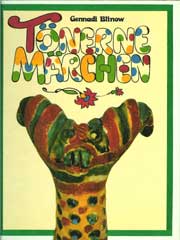 |
 |
 |
 |
 |
 |
 |
 |
 |
 |
 |
: February 2004
|
| |
To A.J. storyteller from the Grimm Brothers' country
Discovery context:
This whistle was found on the sidewalk of a flea market in Paris.
General description:
This whistle is a ram with broad twisted horns. Hidden between the horns and visible in a front view, the head of another small ram emerges.
The eyes are represented by deep holes painted in blue. The tail is represented by a broad half ring.
The decoration:
The top of the whistle is painted in yellow and the lower half in white. Red features underline the body. The yellow part of the body is mottled in blue and red.
|

  
L max: 10,6 cm
H max: 6,9 cm
D max: 6,9 cm |
|
| |
Study of the object Typology: A pipe whistle is inserted in the body of the animal. In the Heide Nixdorf's classification, it is about the B3 type: tubular whistle inserted in the figurine.
Analyze: |
|
| |
No mystery with the origin of this whistle. Its style of decoration and its typology are typical of the whistles of Central Asia: Uzbekistan and Tadzhikistan.
The whistles of these republics are particularly spectacular and our whistle fits well in this tradition.
Tadzhikistan as Uzbekistan share cultures thrusting their roots in a very old and rich history. The art of the north of Tadzhikistan is very close to the Uzbek art and the culture of these areas are difficult to dissociate. This explains the similarity of the whistles of these countries.
|  Traditional painted whistles |
|
| |
 Whistle traditional horse
|
Among the pottery centers of Tadzhikistan, Karatag and Denaou are the traditional centers for the glazed or painted clay toys. The traditional types are the painted whistles in the shape of fantastic lions or horses. Today, the most famous whistles of this area are the whistles of the potter Gafour Khalilov.
In the 1970's, this potter working in Oura-Tioube was a master in making whistles in the shape of lions, dragons and other fantastic figures reaching sometimes more than 40 cm height .
 ===>
G Khalilov 1972 Oura-Tioubé.
H: 25.7, 23.5, 19 cm
Museum of ethnography of the people of Russia
Petersbourg Saint
===> |
|
| |
 German version
Moscow: Edition Raduga 1989
|
The whistle of the month was made in Uzbekistan and in the country of the town of Samarkand, this whistle could only be the hero of a tale from the Arabian Nights
Gennadi Blinow wrote in 1968 this Russian child book. It was translated into German, English and Arabic. In this history, a child asks granny Chamro, a whistle maker, why her horse shaped whistle has such a long neck.
We can learn in the book that granny Chamro is a potter in the village of Uba, province of Buchara. To paint her whistles, she only uses blue, red, green and yellow paintings which she applies with joinded feathers.
The actors of the tale are other animal whistles and in this history, the fantastic animals whistles more simply prove to be horses, lions or elephants.
To know the history of the lion and the horse, the whistle lovers will have to find a storyteller who will be able to make them find again their heart of child...
|  English version
|
|
| |
    |
|
| |
This granny potter is named Chamro Rachimova and still made in 1976 these whistles in the village of Uba.
The other main Uzbek center of clay toys is Samarkand where many whistles are in a dragon shape.
These Uzbek or Tadzhik whistles call for many questions. Why so many figural whistles have on the back the same small animal? Is it to represent the animal and its young? In many cases, it is just a piece of clay
What were the old shapes of these whistles? The importance of these Central Asian areas in the diffusion of the historical culture is well known also the old models of these areas would make it possible to advance in the knowledge of the history of the whistles in Europe. |
 A. Moukhtarov.
Samarkand.
ca. 1980 |
|